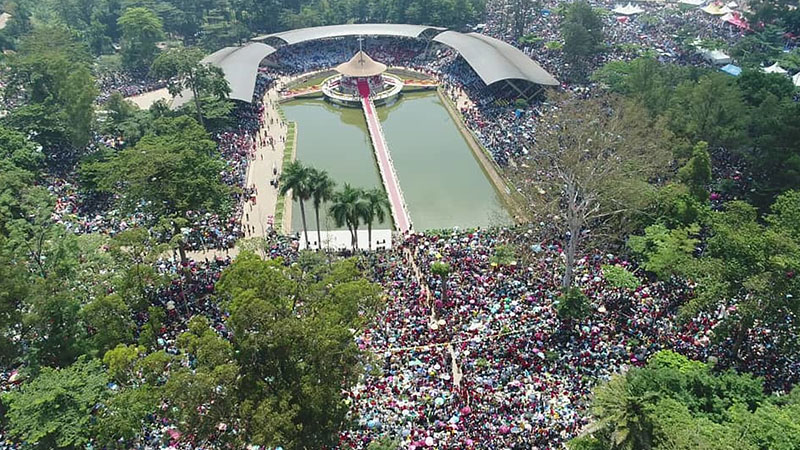Bravo shoes Community Organisation took some time to monitor proceedings at the annual international Martyr’s Day in Namugongo, Wakiso District where hundreds of pilgrimages turn up from different parts of the world.
Among them were children who turned up on their own and those attached to either their parents or their schools. It is 3rd June 2022 and a brave fifteen-year-old Bashir Mwesigwa walked over 200km from Hoima to Namugongo Martyrs shrines in Wakiso district. He spent four days on the road.
As the organization is child-focused, it is important to us that children’s rights are protected and their voices are heard as we work with the government, to empower communities to put children first and to create systems and structures that prevent the unnecessary separation of children.
Like Muwanguzi Alloysious one of the beneficiaries from BravoShoes Community Organisation who skipped school to take care of his father, Mwesigwa a secondary student decided to skip school and make a pilgrimage to Namugongo to pray for wisdom and success.
According to URN, this is Mwesigwa’s third pilgrimage to the site where more than 21 Ugandans were killed for their faith.
While Mwesigwa is at Namugongo, his classmates are in-class learning. According to the calendar from the Ministry of Education and Sports, learners in different educational institutions are supposed to be in school, trying to catch up after the year closure of schools due to COVID-19. The learners will break off this Friday to commemorate the Martyrs’ day.
However, many learners like Mwesigwa, skip school annually to participate in the pilgrimage walking hundreds of kilometers to Namugongo. Many of the learners believe that whatever they pray for will be granted by God because of their sacrifice.
Fourteen-year-old Bernard Tumuhiire accompanied his 66-year-old grandmother from Mbarara on the pilgrimage to pray for the intercession of the martyrs to excel in his studies. While the children trek in groups with adults, after the prayers, some are left behind. In 2019, 110 children remained stranded at Namugongo.
While going on pilgrimage is a sign of faith, some clergy and government officials are against involving children. According to them, parents should not pull children out of school to participate in the walk of faith.
Rev Esau Bbosa Kimanje, the Principal of Namugongo, says that allowing children to take part in the pilgrimage means they miss school which is not a good thing.
However, what is the driving factor persuading children to participate in activities which mean a lot to their lives?
According to Vincent Lubega, a Parish Priest at the Namugongo Catholic Shrine, going on pilgrimage is a sign of faith, there are other things that children can do instead of walking to profess their faith. He, however, says that they are willing to help the children pray for what they want.
Lubega encouraged parents and teachers to consider visiting the Catholic Shrine on other days and not on Martyr’s day since there is a lot of chaos.
Inspired by Saint Kizito
Mwesigwa says he is inspired by the St kizito, a Martyr who represents children. Before he met his death, Kizito walked all the way to Namugongo and was burnt alive with another fellow Christians on the Ascension Thursday, 3rd June 1886.
Saint Kizito born 1872 – June 3, 1886), was one of the Martyrs of Uganda and the youngest martyr was slain allegedly by the King Mwanga II of Buganda. He was baptized on 25/26 May 1886, by Charles Lwanga, the leader of Uganda’s Christian community at the time, at Munyonyo, and burned alive on 3 June 1886 in Namugongo.
He was canonized on 18 October 1964 by Pope Paul VI in Rome. His feast day is on June 3rd. He is considered the patron saint of children and primary schools.
The youngest of the martyrs, Kizito, real father was Lukomera of the Lungfish (Mamba) Clan, and his mother, who bore Lukomera nine children before she deserted him and died, still a pagan, at the age of forty, was Wangabira of the Civet-cat (Ffumbe) Clan.
Nyika, or Nyikomuyonga Guardian of Mwanga’s umbilical cord, often said to be the father of Kizito, was his father by adoption only.
As county chief, Nyika was able to show his gratitude to the members of the Lungfish Clan for their timely relief and assistance. Amongst the appointments he made was that of Kizito’s father, Lukomera, to the chieftainship in the county.
Then, in 1874, Nyika in his turn lost the royal favor. He was deposed, stripped of all his property, and left destitute until the Kabaka relented sufficiently to give him the small chieftainship of Kajongolo. It seems to have been about this time that Nyika decided to adopt one of the sons of Lukomera, who had shared in his downfall. He asked for Nsubuga (later baptized Michael) but Lukomera persuaded him to take Kizito instead.
As a page, Kizito was attached to the group which served in the private quarters of the enclosure and not, as previously thought, to that under Charles Lwanga in the court of the audience hall. It is likely that he had become interested in the Catholic religion before entering the royal service, because Nyika, although too much at¬tached to pagan ways and to his numerous women to become a Christian himself, was very well disposed towards the Catholic Fathers and placed no obstacle in the way of any member of his household who wished to follow their religion.
The youthful Kizito, continuing the family tradition, became an eager and fervent catechumen, seizing every opportunity for instruction and, after the martyrdom of Joseph Mukasa, constantly importuning the priests to baptize him. He seems to have been employed largely as the Kabaka’s errand boy. It was he who was sent to the Lake to order the canoes for Mwanga on a fateful day, 25 May 1886.
He also used to be sent to collect, drive to the Palace and deliver to the royal butchers the cattle selected for slaughter for the royal table. Being young, cheerful, and good-looking, he was also one of the objects of the Kabaka’s unnatural lust. However, in this child of about thirteen the tyrant encountered a resolution and resistance to his gross passion that put him to shame.
Members of his clan suggest that Kizito was about sixteen when presented at Court, but the general opinion of those who knew him is that he was no more than fifteen, at the most, at the time of his death at Namugongo. Nevertheless, despite his youth and his small size, he was sufficiently mature to understand the evils that surrounded him at Court and to understand and love the virtue of chastity.
Kizito demands baptism
Mugagga and Kizito, and their fellow page from the audience hall, Gyavira, all good-looking boys, were special objects of Kabaka Mwanga’s unwelcome attentions but, encouraged by their fellow Christians, had managed to stand firm against both blandishments and threats. Like his companions, the little Kizito, aged about fourteen and the youngest of the martyrs, had no illusions about the danger of resisting his Kabaka’s evil desires.
He was constantly beseeching Pere Lourdel to baptize him because, he said, the Kabaka would not think twice about putting him to death. The priest put him off, telling him that he was too young to know his own mind and also insufficiently instructed; but, refusing to be discouraged, the lad persisted with his entreaties. On one occasion he stayed the whole night at the mission, declaring that he would not leave until the date for his baptism was fixed.
Pere Lourdel promised to baptize him in a month’s time. Before the month was over, Kizito was both baptized and a martyr.
Kizito’s parents plead for his life
Highly placed sources say that Kizito would have been spared by the supreme sacrifice. but having twice already had bitter experience of the effects of the royal displeasure and of the unpredictability of the royal favor dared not risk approaching the Kabaka directly. However, the boy himself, with his eyes on the martyr’s crown so nearly within his grasp.
He did, however, plead with Mukaajanga, the executioner, to spare his adopted son, probably believing that this intervention would prove effective.
In normal circumstances, the wishes of the Guardian of the Cord would certainly have carried great weight, but Mukaajanga had an even greater fear of the Chancellor and was, smarting at the disappointment of being unable to save his own adopted son, Mbaaga Tuzinde. His words to Kizito, when placing him on the pyre, ‘Did you think I would kill my own friends and spare you?’ reveal this bitterness very clearly.
The martyrdom of St. Kizito
But as for Kizito, as young as he was had been somewhat unnerved by these barbarous treatments. On seeing all these, Honorat Nyonyintono, Charles Lwanga, Andrew Kaggwa, Nasibu, and other leading Christians advised the younger pages, Kizito inclusive to flee from the Court for the time being.
These, however, protested that to do so would be equivalent to denying their religion.
On showing such determination, Charles embarked on Kizito. From time to time, an involuntary shudder shook his small frame. Charles tried to reassure him, his voice sweet and persuasive, ‘When the decisive moment arrives, I shall take your hand like this. If we have to die for Jesus, we shall die together hand in hand.’
This indeed became true because when the Kabaka ordered all pages to be assembled and Christians to separate from non-Christians, Charles then, taking Kizito by the hand, and closely followed by the other Christian pages, walked calmly to the spot indicated by the Kabaka.
Pere Lourdel (Mapeera) who was at Munyonyo (but outside the court) seeking an audience with Kabaka, wrote; “I saw little Kizito laughing at the odd situation. He looked as happy as if he were at play with his friends. …
After the sentence, Christians were at once tied in slave yokes and led away to Namugongo to be burnt. From Munyonyo, where the sentence was passed, Kizito, at 14 years, together with fellow Christians matched first to Mengo (about 7 miles) then to Namugongo another distance of about 20 miles with chains, slave yokes, etc around their necks, hands, and legs.


